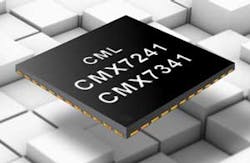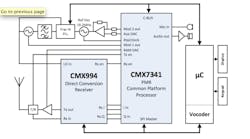This file type includes high resolution graphics and schematics when applicable.
A private mobile radio (PMR) common platform processor to support digital/analog Frequency Division Multiple Access (FDMA) PMR/LMR and 2-slot time division multiple access (TDMA) digital systems has been developed by UK-based low-power wireless semiconductors specialists CML Microcircuits.
Private mobile radio, also known as professional mobile radio (PMR) and land mobile radio (LMR) in the U.S., is a field radio communications system that uses portable, mobile, base station, and dispatch console radios. Operation of PMR radio equipment is based on standards like MPT-1327, Trans-European Trunked Radio (TETRA), APCO 25, and DMR and are designed for dedicated use by specific organizations such as ambulance, fire, and police services.
Following the transition of two-way radio from analog to digital technology, some digital FDMA and TDMA PMR/LMR systems still required radio platforms that could support anlog technology from a legacy perspective.
Complex Design Challenge
With each system potentially having different requirements and specifications that affected the actual radio architecture design, the radio manufacturers' holy grail of a single universal cost-effective radio platform became a complex design challenge.
The rationale behind the CMX7241/7341 PMR Common Platform Processor (Fig. 1) sets out to address this. The CMX7241/7341 provides a common platform that can deliver FDMA digital PMR/LMR, TDMA digital PMR/LMR, and legacy analog. Based on CML's proprietary FirmASIC component technology, a Function Image (FI) can be uploaded into the device to determine the CMX7241/7341 overall functions and operating characteristics.
The first FI focuses on digital and analog FDMA PMR/LMR. It provides a complete feature set including auxiliary functions to support the whole radio. The company says that when combined with its CMX994 Direct Conversion Receiver IC, it presents a flexible, highly integrated radio platform solution.
Operating Features
Main operating features of the processor include automatic analog/digital detection; digital PMR/LMR; ETSI TS 102 658, TS 102 490, and EN 301 166 compliance; embedded air interface physical and data link layers; and mode 1, 2, and 3 operation.
From an analog PMR/LMR perspective, the operational characteristics include: EN 300 086, EN 300 296, and TIA-603-D compliance; complete audio processing; sub-audio signaling; audio-band signaling; and an MPT 1327 modem. The Function Image roadmap includes: DMR, NXDN, and PDT.
Figure 2 shows a typical digital/analog PMR/LMR radio application. The CMX994 Direct Conversion Receiver provides maximum on-chip integration that allows a small RF receiver to be realized with minimal external components. Improvements in semiconductor technologies have seen DCRx increasingly displace superhet as the technology choice for radio receivers in many applications.
Design Flexibility
Earlier this year CML Microcircuits added the 16-FSK modulation to the CMX7164 Multi-mode Wireless Data Modem portfolio.
Addition of the 16-FSK constant envelope modulation is expected to enhance the design flexibility of this modem IC, enabling telemetry systems to evolve into higher data throughput without the need to move to a linear modulation scenario.
The CMX7164 covers both constant envelope and linear modulation schemes including GMSK/GFSK, 2/4/8/16-level FSK, and 4/16/64 QAM, and also provides a good platform to support customer-specific modulation schemes.
The CMX7164 is available now, offering low-power 3.3V operation in small VQFN/LQFP packaging.
This file type includes high resolution graphics and schematics when applicable.



